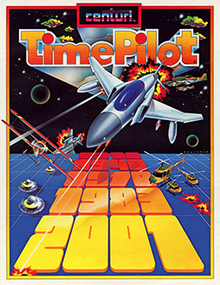Time Pilot
| Time Pilot | |
|---|---|
 North American arcade flyer | |
| Developer(s) | Konami |
| Publisher(s) | |
| Designer(s) | Yoshiki Okamoto |
| Artist(s) | Hideki Ooyama |
| Composer(s) | Masahiro Inoue |
| Platform(s) | Arcade, Atari 2600, MSX, ColecoVision |
| Release | Arcade
|
| Genre(s) | Multidirectional shooter |
| Mode(s) | Up to 2 players, alternating turns |
Time Pilot (タイムパイロット, Taimu pairotto) is a multidirectional shooter designed by Yoshiki Okamoto and released in arcades by Konami in 1982. It was distributed in the United States by Centuri.[3] While engaging in aerial combat, the player-controlled jet flies across open airspace that scrolls indefinitely in all directions.[4][5] Each level is themed to a different time period. Home ports for the Atari 2600, MSX, and ColecoVision were released in 1983.
A top-down sequel, Time Pilot '84, was released in arcades in 1984. It drops the time travel motif and instead takes place over a futuristic landscape.
Gameplay
Players assume the role of a pilot of a futuristic fighter jet trying to rescue fellow pilots trapped in different time eras. In each level, players battle enemy aircraft and then a stronger aircraft. Players' fighter jet is in the center of the screen at all times. Players eventually battle a mothership of the time period they are in; once the mothership is defeated, they move onto the next time period. Parachuting pilots will occasionally appear and award players points if collected.
There are five levels: 1910, 1940, 1970, 1982/1983, and 2000. After the fifth level is finished, the game repeats thereafter.
Extra lives are given at 10,000 points, and per 50,000 scored up to 960,000; thereafter, game goes to "survival of the fittest" mode.
Fighters are destroyed if they collide into bullets, enemy ships, or missiles. Game ends if last fighter is destroyed.
Development
According to his account, Yoshiki Okamoto's proposal for Time Pilot was initially rejected by his boss at Konami, who assigned Okamoto to work on a driving game instead. Okamoto secretly gave instructions to his programmer to work on his idea, while pretending to be working on a driving game in front of his boss.[6]
Reception
In Japan, Game Machine listed Time Pilot on their June 1, 1983 issue as being the eighteenth most-successful table arcade unit of the year.[7]
Legacy
Re-releases
- PlayStation as part of the Konami Arcade Classics compilation in 1999.
- Game Boy Advance as part of the Konami Collector's Series: Arcade Advanced compilation on March 18, 2002.[8] This version includes a hidden sixth era, 1,000,000 BC, where the player must shoot pterodactyls.
- Xbox 360 as part of Xbox Live Arcade on August 30, 2006.[9]
- Nintendo DS as part of Konami Classics Series: Arcade Hits.
- Released for i-mode mobile phones in Japan in 2004.
- A special version named Time Pilot '95 also appears in the Super Famicom game Ganbare Goemon Kirakira Douchuu: Boku ga Dancer ni Natta Wake (of the Ganbare Goemon series), and can be unlocked when the main game is completely cleared.
- A version of the game for Xbox Live Arcade by Digital Eclipse features optional updated graphics, although the game plays identically (it is a port of the original).
- The emulated version was re-released in 2005 for PlayStation 2 in Japan as part of the Oretachi Geasen Zoku Sono-series.
Clones
Fury is a 1983 clone from Computer Shack for the TRS-80 Color Computer.[10]
Two unrelated clones with the same name were released in 1984: Kingsoft's Space Pilot for the Commodore 64[11] and Superior Software's Space Pilot for the BBC Micro.
Unfinished projects
A remake of the game was rumored to be in the works for the Nintendo 64.[12]
References
- ^ Time Pilot at the Killer List of Videogames
- ^ "Time Pilot arcade video game by Konami". Arcade History.
- ^ "Overseas Readers Column - Konami's Video "Time Pilot" Licensed To Century Of U.S.A.". Game Machine (in Japanese). No. 203. Amusement Press, Inc. 15 December 1982. p. 30.
- ^ "Konami Classics Series: Arcade Hits - NDS - Review". GameZone. April 9, 2007. Archived from the original on 2013-01-27. Retrieved 2011-04-08.
- ^ "Konami Arcade Classics: Well, at least it's classic". IGN. January 7, 2000. Archived from the original on 2013-01-27. Retrieved 2011-04-08.
- ^ Kent, Steven. "VideoGameSpot's Interview with Yoshiki Okamoto". Archived from the original on December 7, 1998.
- ^ "Game Machine's Best Hit Games 25 - テーブル型TVゲーム機 (Table Videos)". Game Machine (in Japanese). No. 213. Amusement Press, Inc. 1 June 1983. p. 29.
- ^ "GBA Gems: Konami Collector's Series: Arcade Advanced". IGN. IGN. Archived from the original on 2013-01-27. Retrieved 2006-09-01.
- ^ "Time Pilot Flies Onto Xbox Live Marketplace". TeamXbox. IGN. Archived from the original on 2013-01-27. Retrieved 2006-09-01.
- ^ Boyle, L. Curtis. "Fury". Tandy Color Computer Game List.
- ^ "Space-Pilot". Lemon64.
- ^ "Gaming Gossip". Electronic Gaming Monthly. No. 99. Ziff Davis. October 1997. p. 38.
External links
- Time Pilot at the Killer List of Videogames
- Time Pilot at the Arcade History database
- Time Pilot entry at the Centuri.net Arcade Database
